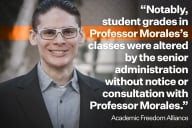You have /5 articles left.
Sign up for a free account or log in.

Istockphoto.com/fizkes
Defining the value of a college major is tricky, in part because students typically aren't fully rational when picking one. Likewise, career paths are increasingly hard to predict, with a growing number of job changes for graduates looming in the fast-moving knowledge economy and automation also playing a bigger role.
New data from Emsi, a labor market analytics firm that is part of the Strada Education Network, sheds light on the career tracks for graduates of six relatively common academic programs, with widely varying levels of perceived applicability to jobs: languages and philosophy, the social sciences, business, communications, engineering, and IT.
Not surprisingly, the typical path is more of a swirl than a straight line.
“The results don’t look like neat cohorts entering a few high-profile careers with perfect intentionality,” Rob Sentz, the new report’s co-author and chief innovation officer at the nonprofit Emsi, said in an email. “Instead, we see something that looks much more ‘real’ people moving in the market based on a complex web of factors, changing over time, finding their way and adapting as they go.”
The report is based on Emsi’s database of 125 million professional profiles, taken from résumé repositories, applicant tracking systems and other sources. It analyzed profiles of graduates of four-year colleges that mentioned the six specific degree programs, tracking the first three jobs they held after college.
“We now have a clear characterization of their actual work,” Sentz said, despite the “crazy flow between these jobs.”
The bottom line, Sentz said, is that the six majors were “not totally deterministic, but not totally irrelevant” to career pathways.
The top career findings for each major track were the expected ones. For example, engineering grads were mostly likely to work in industrial and mechanical engineering for their first job (20 percent), followed by software development (13 percent). Language and philosophy grads went into education first (17 percent) and journalism and writing (10 percent).
After those jobs, however, the report starts to look more like the findings from a study from the Federal Reserve Bank of New York, which found that only 27 percent of college graduates work in a field related to their major.
Emsi found that most graduates’ outcomes are dispersed widely, among a broad array of careers. They tend to move in and out of careers during their first, second and third jobs. And those job changes often take graduates into totally different fields.
Yet the data also show several clear patterns.
Perhaps most notably, sales, marketing, management and business, and financial analysis were common jobs for graduates of all six majors, typically as one of the top 10 job outcomes.
The report also found that roughly half of all the tracked jobs (54 percent) were in major business functions, which include tactical communication, strategic communication, interpersonal oversight and operational oversight. In comparison, one-third of graduates went into STEM jobs, and one-fifth worked in “soft skill” jobs.
Philosophy and Practical Skills
“This really makes a strong case for work-based learning,” said Jane Oates, a former official in the U.S. Department of Labor during the Obama administration, who is now president of WorkingNation, a nonprofit organization.
Lynn Pasquerella, president of the Association of American Colleges and Universities, agreed with Oates.
“Colleges and universities need to provide students with practice,” she said, “in the context of the workplace.”
The dominance of business functions in the report’s findings isn’t a surprise, Sentz said, given the nearly 15 million sales jobs in the economy, which stretch across every sector and region. Likewise, the report said jobs in marketing, public relations and advertising have grown in popularity by 62 percent over the last decade.
“There is an enormous part of the economy hungry for graduates with skills in analysis and communication -- skills students are honing as they conduct close readings of texts, persuade their classmates in seminars and hone the style and structure of papers,” Sentz said.
That might not be clear to students, however, or to college leaders.
“Students outside STEM fields often lack the sense that they are gaining discrete, in-demand skills in the course of their studies,” he said. “Consequently, they do not perceive a clear line between their education and the working life for which it laid the foundation.”
The report provides new and novel data to back the growing understanding that the college-to-career path typically is not linear, said Stephen Yadzinski, managing director of JFFLabs at Jobs for the Future, a nonprofit group.
“Human beings do this as a network of choices,” he said.
Yadzinski said the report also includes good news for students, because the most popular skills it identifies “are the things that are not automated as easily.”
The numbers have value in the aggregate, several experts said, because they give a more nuanced view of how popular majors, including ones in the humanities, do in fact prepare graduates with skills to help them thrive in the workforce.
The report shows that disciplines that don’t seem to directly apply to the labor market (think the welders-versus-philosophers canard) often do, said Pasquerella. It’s an analysis “that can help college and university presidents articulate the value of the liberal education they’re offering,” she said.
College leaders can use the numbers to get granular as well, said Sentz. He said Emsi is working with 100 or so colleges to do the mapping of first three jobs by graduates’ major, and can give specific numbers for which employers are hiring those graduates. For example, he said, a community college could tell a big accounting firm that 25 of its employees graduated from the college, including liberal arts majors who didn’t study accounting.
“This is where a lot of this data on labor markets are headed,” Sentz said, meaning the “flows of degrees into work.”
Sentz said colleges can use the report to help reverse engineer degree programs to more explicitly link valued skills to common career paths.
Employers should use the data as well, said Oates.
“I don’t think the employers are very good at identifying the skills needed for a job,” she said, adding that it’s not enough for colleges alone to change to be more intentional about including workforce-relevant skills to degree programs. “Employers have to be doing this simultaneously.”







